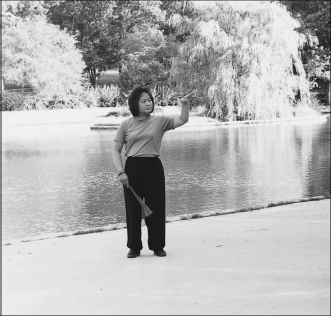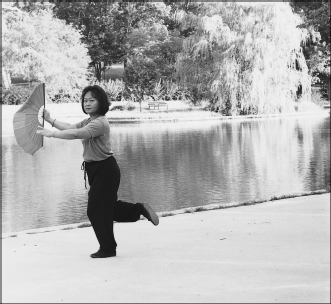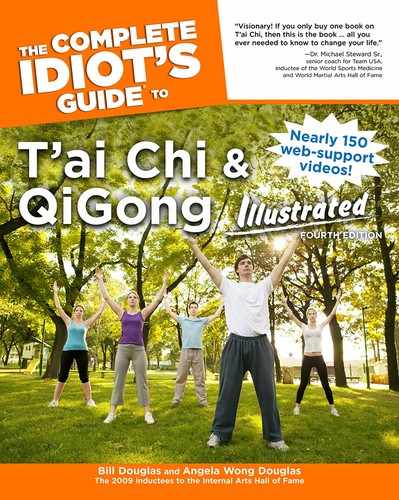Chapter
15
Mulan Quan Fan Style
In This Chapter
• Discovering the benefits of Mulan Quan
• Using Mulan Quan as emotional therapy
• Finding the pearl within you through Mulan Quan
• Web Video Support: Exhibition of Entire Mulan Quan Single Fan Style
Mulan Quan is based in traditional T’ai Chi movement and wushu (Chinese for “martial arts”). However, it adds aspects of Chinese folk dance and gymnastics to provide a vessel of motion for the beauty of the practitioner to be poured into. Mulan Quan, therefore, reaches to the outward limits that the practitioner can express, both with the wushu aspects and even as a spectacular sword form (which I give examples of in Chapter 16). Yet it also explores the softest, most delicate aspects of the user, which is most beautifully expressed in the Mulan Quan fan style. (Note that several other T’ai Chi styles offer fan versions, in addition to the Mulan style; by exploring via www.worldtaichiday.org, other books, and Appendix C, you’ll find much more on this.)
There are two fan styles: the single fan and the double fan. This chapter introduces you to the basic single-fan style, by exposing you to how the forms look and elaborating on how they’re performed and what benefits each provides.
This chapter gives you an overview of some of the Mulan Fan Style forms; however, its Web Video Support provides the Exhibition of Entire Mulan Quan Single Fan Style video, showing all the movements in this form, meant to enhance your general knowledge of T’ai Chi fan styles.
Mulan Quan styles are rapidly gaining popularity and have been involved in exhibitions and competitions from Beijing to Kansas City. Work is being done to eventually introduce Mulan Quan as Olympic competition.
This section’s movement works and stretches the entire body. Refer to the Web Video Support’s Exhibition of Entire Mulan Quan Single Fan Style as you look through the following descriptions.

Notice here how this motion exercises the arm muscles and loosens the joints as you relax into the pose.

Flying Bees Through Leaves is quite graceful, but the movement is only a vessel through which to express yourself. Enjoy as you experience your own grace being poured into the vessel of your T’ai Chi. Furthermore, it tonifies the entire body from head to toe.
Promoting equilibrium and refinement, this series is internal and subtle, yet externally strengthening to all muscles.

While strengthening the leg muscles, this movement fosters an internal awareness that improves your balance.

The external motion is refined by encouraging the practitioner to “feel elegant.” Of course, besides that mental and spiritual benefit, it has a very practical purpose of working and loosening the arm’s joints.
The beautiful names of this section are inspiring, but the movements hold even more. While creating very solid strengthening, these movements also affect the way we feel about ourselves. Mulan Quan can literally transform our self-esteem.
Miracle Dragon Lifting Head is actually well named because moving in a posture of head-lifted self-esteem (which T’ai Chi requires) actually transforms the practitioner over time in ways that may seem miraculous. Mulan Quan may be a powerful adjunct therapy for the many emotionally affected conditions, such as eating disorders, facing some young people today.

The Miracle Dragon Lifting Head encourages the practitioner to lengthen, thereby enhancing and promoting good posture.
| T’AI SCI |

This movement powerfully strengthens the leg and back muscles while promoting release of tension through the back. (For a visual example of this movement, see it in the Mulan Fan Style T’ai Chi section on the Web Video Support.)
This section offers great overall toning exercises, and its delicate footwork especially focuses on toning in the leg.

The deep rotation of the hip of Green Willow Twigs Swaying allows a subtle internal awareness of how the body shifts from its power point, or dan tien. (For a visual example of this movement, see it in the Web Video Support’s Mulan Style T’ai Chi section.)

This posture works all the joints and muscles, offering great strengthening and toning throughout the entire frame.

The delicate footwork of Dancing in Wind is a great toning exercise for the legs, and its subtlety offers a meditative quality as it’s performed.
While challenging the lower body to maintain balance, the upper body is rotated and flexed in a soothing, relaxed way.

The shoulder and wrist rotations of this motion release stress and soothe your mind as you flow through its graceful ways.

The spine and waist are flexed gently, promoting a litheness that is not only lovely but enhances all aspects of health, according to Traditional Chinese Medicine.
While the legs work and adjust to subtle posture changes, the upper body is gently stretched and loosened.
The Least You Need to Know
• Mulan Quan can change your self-image, which can positively change your physical appearance over time.
• Mulan Quan’s self-esteem promotion may be a wonderful adjunct therapy to women facing emotional problems, as well as men.
• The elegance Mulan Quan offers is really within you right now! Mulan Quan only helps you to loosen up and express that part of yourself.

